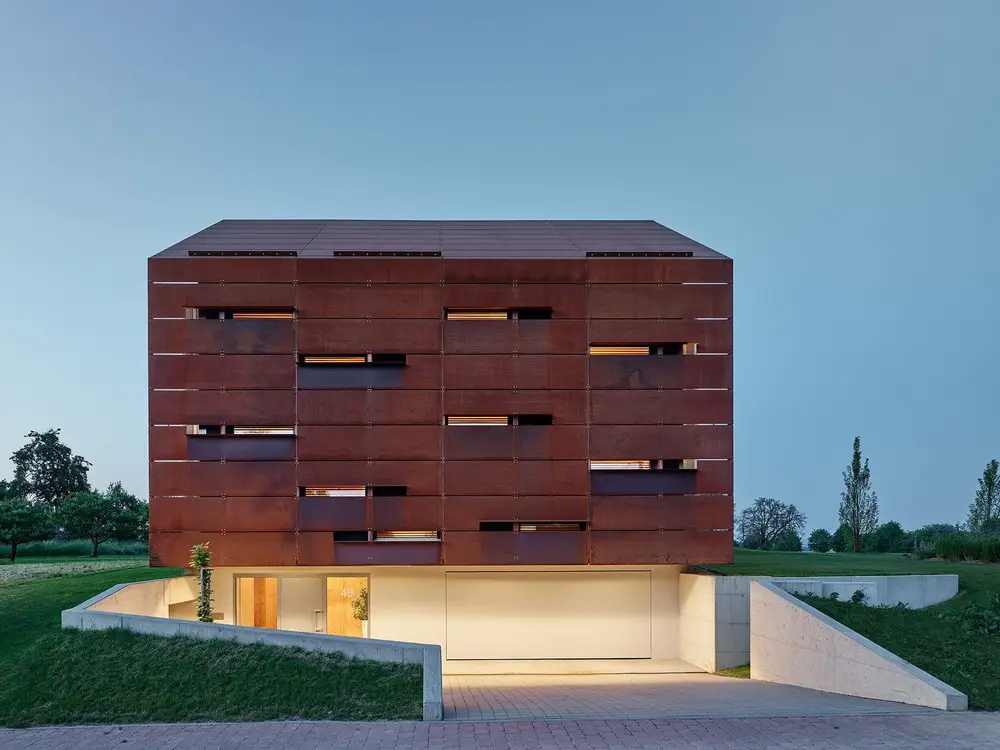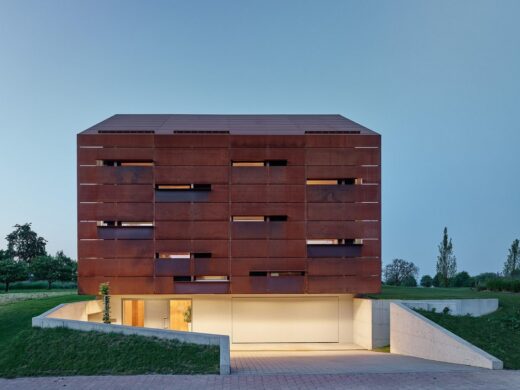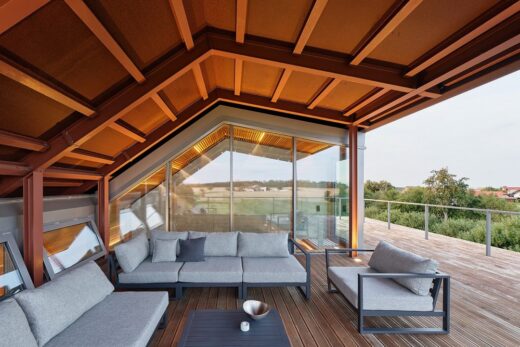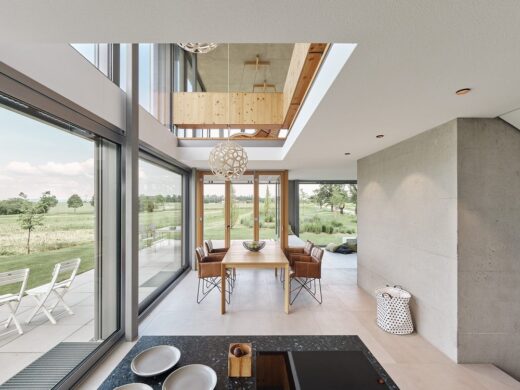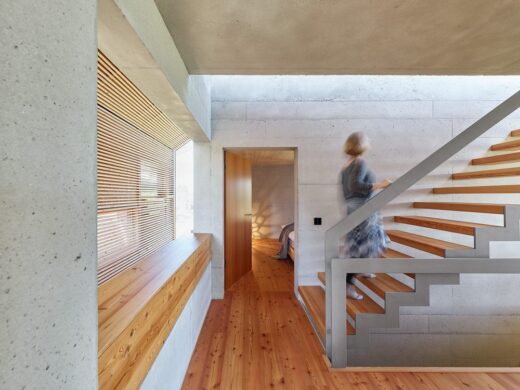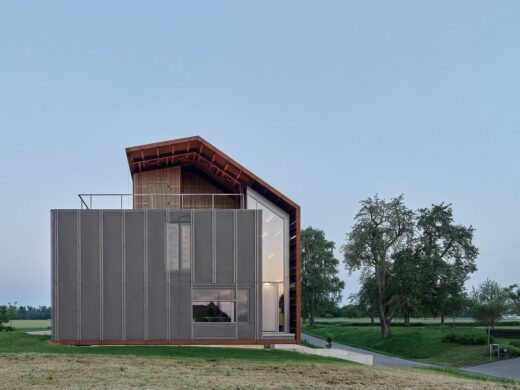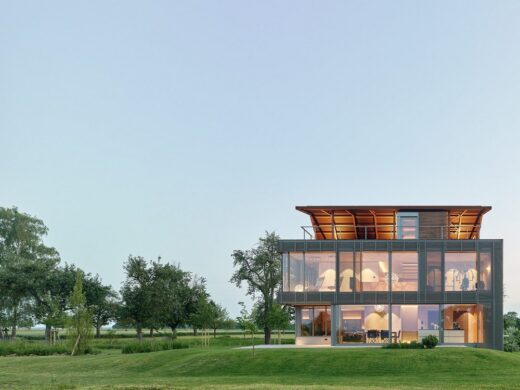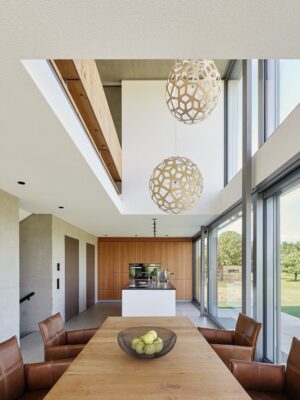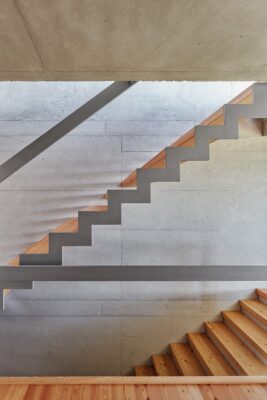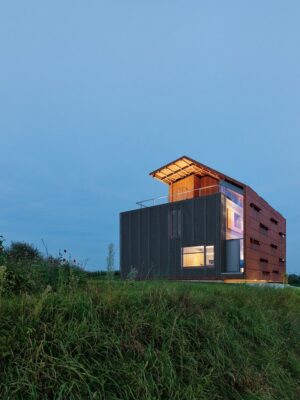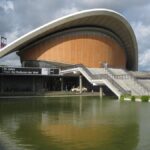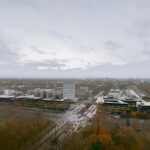House L49 Tübingen, Modern Baden-Württemberg home, southwest German eco property, Architecture images
House L49, Tübingen eco property
26 Sep 2022
Design: METARAUM Architects – Wallie Heinisch, Stuttgart
Location: Tübingen, Baden-Württemberg, southwest Germany
Photos by Zooey Braun
House L49, Germany
Location concept/initial situation: Felldorf is a small village, part of the municipality of Starzach in the district of Tübingen. It is rural in character and has little more than 750 inhabitants. A strip of land along the exit from the town, which is lined with apple trees, is designated by the municipality as a smaller building land area. The last plot is owned by the builder’s family and can now be built on to a small extent.
The rest remains grassland. The country road on which the property is located leads into the village with embankments on both sides and sloping terrain. Above the road, the highest area of Felldorf, the sweeping view of the softly undulating landscape opens up with its scattered farmsteads, forest islands and fields. Now the new house is the first house at the entrance to the village, previously it was a weather-beaten barn.
Architectural construction concept: The client for House L49, who is himself a structural engineer, and the client, who is entrepreneurially active in the field of renewable energy with a focus on geothermal energy and heat pump systems.
They envisioned a modernistic, cubic residential building supported by a sustainable building concept. The house should have an external connection, with various terraces to enjoy the views of the landscape.
In thorough preparatory work and in constant dialogue with the client, the architect compiled a catalog of goals for the residential building as the basis for the architectural concept of the building:
1. Future-proof building concept, using regenerative energies for electricity and heating, natural ventilation and as little technical equipment as possible Expenditure.
2. Best reference of the living space to the landscape, with well usable outdoor areas.
3. Take into account the special location of the building at the village entrance with a rural character.
4. Street facing privacy screen of entrance and living areas.
5. Multi-storey, open floor plan that can be used flexibly in parts, which also allows for retreat areas.
-A surprising approach and development
Slopes towards the street, the buildable part of the property is about 1.50 m above street level. From here, blocked by the avenue of fruit trees and the embankment, the impressive view over the landscape only opens up above the embankment.
This element of surprise was to be incorporated into the design of the building. Therefore, access to the house is via an access courtyard dug into the embankment, which, in addition to the access to the underground car park, also includes the protected area in front of the entrance. The building, which looks cubic and homogeneous as if placed on the site, pushes over the basement in such a way that a covered development of the house is created over the entire length of the courtyard. From the hallway in the basement, which is paved like the courtyard, you climb up a single-flight staircase to the living rooms and are greeted by the impression of the vastness of the landscape.
-Like on a ship’s deck
The terrace desired by the client with a view from a higher vantage point was implemented in a striking manner by covering the entire roof surface of the building cube with robinia wood floorboards, which conveys the feeling of standing on a ship’s deck. So that staying on the roof is protected from the sun, wind and weather and is not exposed to views from the neighborhood, a south-west-facing, shielding steel roof was constructed.
-The shielded cube
The shielding roof of the building develops in the form of a hinted gable roof from the street facade, inclines over large parts of the roof terrace and includes the staircase. With this sloping canopy, the cubic-modern basic body of the house makes a reference to the rural building forms and fits well into the context, without ingratiating itself with the rural building style. The façade facing the street, set at a distance from the cube, runs seamlessly into the shielding roof. Corten steel was chosen as the material, which, like the neighboring wooden barn, develops a beautiful, changing patina. The cube appears on three sides of the building, facing the landscape. The joint between the street-side corten steel facade and the cube is not only important for the legibility of the building figure, but is also essential for the spatial experience inside the house.
-Spatial concept/use:
The two-storey cube, which sits on the basement, forms the core of the residential building, with living and working areas on the ground floor and the sleeping and fitness rooms with bathroom and sauna on the upper floor. Crowned by the fully usable roof area, the “deck”. The uses on the levels are openly connected to each other, but can be closed off if necessary using sliding doors and folding walls. The rooms are also vertically connected to each other through two architecturally distinctive air spaces. This creates a highly communicative spatial structure and a dynamically adaptable room layout. All storage furniture and cupboards are structurally integrated, as built-in cupboards, room-accompanying lowboards or as parapet walls. Barrier-free bathrooms and a provision of elevators enable the builders to be able to live in their house even in old age.
-Ground floor
A single-flight exposed concrete staircase leads towards the light from the hallway in the basement, up to the living area on the ground floor. The unobstructed view of the landscape that greets the visitor at the stairway between the kitchen and dining area is a special event in the choreography of the house. The living area is organized as an open floor plan around the concrete core of the staircase. The floor covering in front of the kitchen and the dining area is also continued here (as in the basement) into the outside space and gives the efficiently dimensioned room visual width with the connection to the landscape. Above the dining area, the room expands upwards – to the atrium – with reference to the upper floor.
The office (also the guest room) at the end is accessed in this space gap and has its own access to the outside. In addition, this atrium provides access to the artistically tiled guest bathroom and the stairs to the upper floor. The atrium, the room gap, which runs into the transition of the roof area and is clad on the inside with horizontal larch wood slats, buffers the direct south-western sunlight, but allows effective light reflections through its narrow openings, distributed irregularly over the entire inner facade, depending on the position of the sun create space and catch a glimpse of parts of the landscape. The uniformity of the room illumination, including the utility rooms connected to the windows, is guaranteed by the high glazed front sides of this room joint.
As an extension of the dining area, the covered outdoor dining area connects to the corner of the building, the living area runs at an angle to this, which shows a different direction of view of the landscape with generous panoramic glazing. As a result, the living area overlaps with the 2-storey, elongated inner room of special spatial quality: it is the spatial joint between the street facade in the south-west and the actual building cube, which shows its inner facade in this spatial joint. At the same time, this room acts as a “filter” with the south-west facade closed on the street side and only provided with irregular window slits and as an “inner foyer” for the cube.
-Upper floor
The stairs to the upper floor lead from the high atrium back to the side of the house facing the landscape. Here one looks down at the atrium, which is surrounded by raised storage furniture, into the dining area. On one side is the open relaxation area, which is connected to the sauna and the bathroom. On the other side of the atrium there is a room separated from the atrium by a wall panel (open or closed by a sliding door), which can be used flexibly, but currently as a training room is operated.
The bathroom can be accessed from two sides: from the relaxation area, or from the hallway at the atrium of Raumfuge. The bathroom gets its atmosphere through an internal window opening from the wood slat-clad atrium, as well as the play of light and the landscape details of the window slits in the outer wall. These internal window openings of the cube into the atrium of the Raumfuge are repeated in the hallway and in the sleeping area. The bedroom, in addition to its window into the atrium, which can be closed with wooden sliding elements, is only illuminated in the dressing room area with a narrow, high window.
The staircase now leads up to the roof terrace as an open steel staircase with block steps made of larch wood. The light from the exit falls through the open staircase construction into the hallway area of the upper floor and also contributes to the fact that the house with a room depth of approx. 12 m appears bright and friendly in all areas. The consistent choice of materials of satinised exposed concrete, rustic larch wood floors and fixtures, the large-format, homogeneously colored ceramic tiles on the ground floor and the wet areas allow the house to appear in a contemporary design language, but never unapproachable and cool.
Construction and sustainable choice of materials
With the specification of designing a slender supporting structure open on three sides, the main supporting structure was chosen as a reinforced concrete structure for economic reasons and taking into account the prevailing earthquake zone. The massive cube is braced by the wall panel on the north-west side and the elevator core. The concrete construction also serves as a storage mass and is tempered in parts. A steel construction was chosen for the slender outer supports, as well as the presented south-west facade and the umbrella overhanging the cube.
This is used to attach the CorTen steel cladding and the suspended wooden frame construction of the thermal shell, which is also the longitudinal reinforcement of the steel construction. The thermal shell of two of the three outer sides of the cube consists of a large-format glass facade with window openings.
In the building energy concept, the clients pursued the vision of the best possible efficiency with regional use of geothermal energy and the implementation of a ground-coupled heat pump system, taking into account the motto “keep-it-simple & smart”. The underground is used for heat extraction in winter and for heat recirculation in summer.
In addition to underfloor heating, the ceilings in the building were also thermally activated. About 700 m of pipes for the temperature control of the concrete core were laid on the lower reinforcement of the ceilings, so that four heating and cooling circuit distributors are available in the building. Despite the high-quality BUS system in the building, the heating circuits are not controlled via the BUS system, but are adapted to the requirements of the client and the climatic conditions and seasons via the automatic control of the HP in such a way that this is done comfortably, efficiently and with little interference in the building can. Several temperature sensors are integrated in the floor and ceiling of the building, so that the daily and seasonal temperature profiles in the building harmonize with the requirements.
The insulated concrete surfaces, especially on the closed north-west facade, are sealed with a foil that matches the metallic color of the facade profiles and the translucent expanded metal facade used as a cladding.
The choice of material fell on steel for the facades and essential parts of the construction, which guarantee a long service life without the usual renovation effort, uncoated solid wood for wall constructions and fixtures and glass. Materials that can be dismantled or recycled again according to type after the building’s life cycle. Only the basement, stair core and ceilings are made of reinforced concrete and form the simple spatial framework that allows for a completely different room layout or use if required.
Energy Concept (Simone Walker-Hertkorn)
In the building energy concept, the clients pursued the vision of the best possible efficiency with regional use of geothermal energy and the implementation of a ground-coupled heat pump system, taking into account the motto “keep-it-simple & smart”. The underground is used for heat extraction in winter and for heat recirculation in summer. In addition to underfloor heating, the ceilings in the building were also thermally activated.
About 700 m of pipes for the temperature control of the concrete core were laid on the lower reinforcement of the ceilings, so that four heating and cooling circuit distributors are available in the building.
In the geothermal system, just as in the building distribution system, a water-antifreeze mixture is low concentration (10%) is used so that the corresponding temperatures can be transferred from the subsoil to the building without system separation.
Despite the high-quality BUS system in the building, the heating circuits are not controlled via the BUS system, but are adapted to the requirements of the client and the climatic conditions and seasons via the automatic control of the HP in such a way that this is done comfortably, efficiently and with little interference in the building can. Several temperature sensors are integrated in the floor and ceiling of the building, so that the daily and seasonal temperature profiles in the building harmonize with the requirements.
The rather open room concept means that the warm rooms (bathroom, relaxation room, sauna, sports room) are on the upper floor and the technical rooms and the entrance area are on the lower floor. The temperature stratification in the building
corresponds to that of a stratified storage tank by gravity. A photovoltaic system is integrated in the non-visible area of the roof surface facing the landscape, which supplies the building with a not inconsiderable part of the required electricity.
The domestic hot water preparation takes place in the summer phase between 10 a.m. and 2 p.m. in order to be able to use the PV modules on the eastern half of the roof effectively on sunny days. 6.3 kWp PV modules are positioned on the entire east side.
The building technology is neither visible nor audible in the building: The usual ventilation system in the new building (with the exception of the extractor hood above the stove) was completely dispensed with, but there are CO2 sensors in sensitive rooms that can control individual windows on the roof to to allow air exchange.
The 2 air spaces and the overall open construction, within and between the individual floors, show that the CO2 content in relation to the room air is not exceeded.
House L49 in Tübingen, Germany – Building Information
Architects: METARAUM Architects – https://www.metaraum.de/ – Wallie Heinisch, Stuttgart
structural engineering: Rößler Hertkorn GmbH – Jürgen Hertkorn, Herrenberg
Building technology – geothermal energy: Simone Walker-Hertkorn, TEWAG GmbH, Starzach
Completion: June 2019
Façade: Kubus
Façade west/roof: corten steel/wood
Interior: larch
Flooring – ground floor and wet rooms tiles: Diele Kleinpflaster
PV system: 6.3 kWp Power generation PV system from the beginning of February to November around 4200 kWh. In the 5 summer months there is a 70/30 ratio between electricity generation and electricity consumption.
Heat output of the heat pump DHW storage tank yearly full usage hours i.e. WP: 6.8 kW (fix speed heat pump) approx. 800 l (DHW target temperature setting of 46 °C) ca. 2.300h bis 2.400 h/a
Heat source: Trench collector (700 m of 63 PE pipe laid in a ring, connected directly to the building services engineering without a distributor and without system separation); In 2020, the determined annual performance factor (JAZ) in the area of heating was 5.0; in the area of domestic hot water TWW 4.4 and total 5.0; in summer the highest heat source temperatures are + 17 °C and in winter the lowest temperatures are + 1 °C.
Photography: Zooey Braun
House L49, Tübingen Germany images / information received 260922
Location: Tübingen, Germany
Architecture in southwest Germany
Southwest Germany Architecture
Multi-Family House, Aichwald, Baden-Württemberg
Design: holzerarchitekten
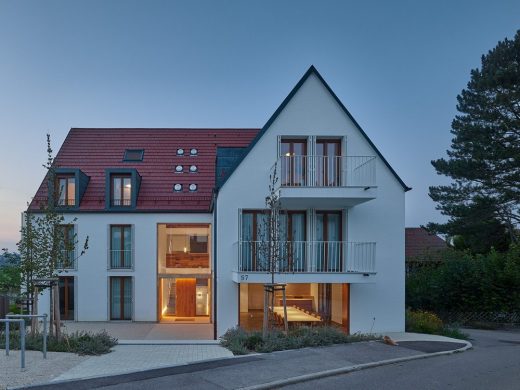
photo : Zooey Braun, Stuttgart
House in Aichwald Baden-Wurttemberg
House am Oberen Berg
Architect: Alexander Brenner Architekten
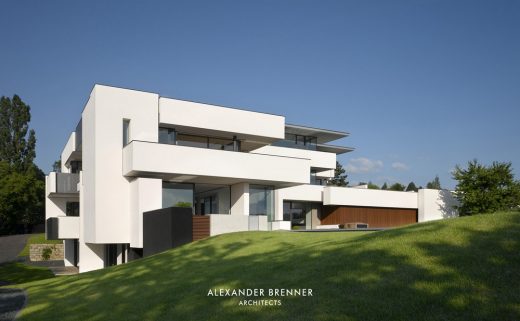
photo : Zooey Braun, Stuttgart
House am Oberen Berg
Renovation and extension of a semi-detached Wohnhaus
Architects: Holzer Architekten
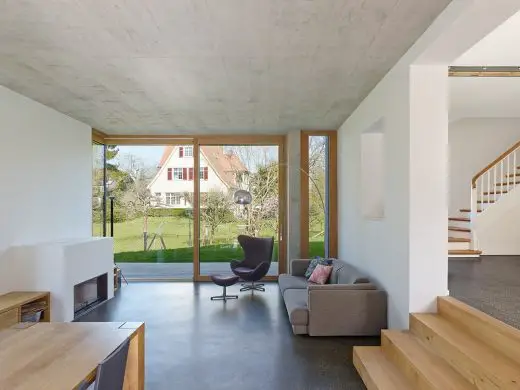
photo : Zooey Braun
Wohnhaus in Stuttgart
German Buildings
German Architecture
German Architecture Designs – chronological list
New German house : Dupli.Casa – House near Ludwigsburg
Comments / photos for the House L49, Tübingen Germany building design by METARAUM Architects page welcome

